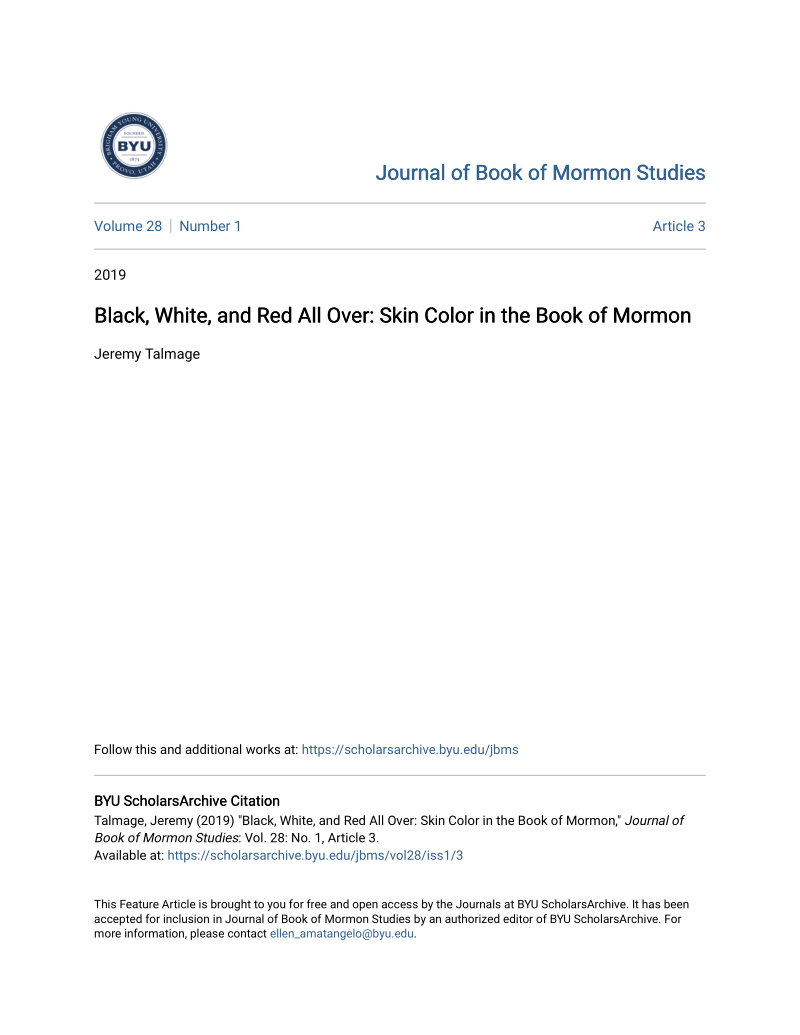Jeremy Talmage argues that the description of Native Americans as "black" contrasts with the 19th-century description of natives as "red."
- Type
- Academic / Technical Report
- Source
- Jeremy Talmage LDS
- Hearsay
- Direct
- Reference
Jeremy Talmage, "Black, White, and Red All Over: Skin Color in the Book of Mormon," Journal of Book of Mormon Studies 28, no. 1 (2019): 49-50, 52-54, 67
- Scribe/Publisher
- Journal of Book of Mormon Studies
- People
- Jeremy Talmage
- Audience
- Reading Public
- Transcription
Nearly all examinations of race in the Book of Mormon, however, have generally made unfounded assumptions about the book's working racial paradigm, the most recent scholarship not excluded. Though noting the Book of Mormon's prediction about a future racial order, they essentially agree with many others that nineteenth-century notions about race undergird the text's framework. In doing so, they have overlooked or misconstrued its comments on the most prominent feature of Indian - ness-skin color. While this paper will not respond to all the supposed correspondences between the Book of Mormon's views about race and Joseph Smith's culture, it will demonstrate that the book expressed vastly different presumptions about the complexion of Native Americans. In the 1830s, American Indians were overwhelmingly described as red, something the Book of Mormon never does. In the nineteenth century, white, black, and red were clear-cut color classifications that carried with them expectations of origin, nature, and rights. Images of Indians as "red skins'' pervaded all aspects of culture, from scientific treatises on race to poetry, hymnody, and literature. Almost no one, excepting in the Book of Mormon, styled them as black, which was a descriptor reserved solely for Africans in antebellum America. After analyzing the history of the racial categorization of Native Americans, contemporaneous descriptions of Indians in potential sources of the Book of Mormon, and the perseverance of these ideas, it becomes clear that the Book of Mormon's views about skin color were unique and did not match the prevailing racial attitudes of the time. For a book supposedly about the origins of the "red man;' it curiously pictured Native Americans in black and white.
. . . .In an effort to simplify the world's racial diversity, European scientists introduced a color-based racial classification system that quickly became the predominant way to imagine Native Americans. The soon-to-be common association of Africans as "black;' Europeans as "fair;' and Americans as "copper-colored" first appeared in Carl Linnaeus's 1740 Systema Naturae. A few years later, in 177 4, a French priest who had traveled through America noted the widespread view that "many believe[ d]" that Indians "constitute[ d] a third species of men between the blacks and whites;' agreeing that the natives were "very swarthy and of a dirty dark red;' with a "copper complexion:' The next year, in 1775, this hard-and-fast classification of Caucasians as white, Africans as black, and Native Americans as "copper colored" was all but cemented when the distinguished German naturalist Johann Friedrich Blumenbach published his influential On the Natural Variety of Mankind. It was no surprise, then, when later European explorers and politicians described Native Americans as "naturally of a colour bordering upon red" and as "all of a copper colour:'24 Scientific encyclopedias marveled at how, among Indians of all parts, "distinction of colour was not to be found. In the torrid zone there were no negroes, and in the temperate and frigid zones there were no white people. All of them were a kind of red copper colour:'
Americans quickly followed suit by adopting red as the common descriptor of Indian skin tone. . . ."Red" replaced all other descriptions of Native American skin color and remained so well into the early twentieth century. The Book of Mormon's portrayal of "red men'' as possessing a "skin of blackness" was certainly unconventional.
. . . .The racial worldview of the Book of Mormon is a historical anomaly in that it envisioned Native Americans as either black or white when nearly everyone else identified Indians as red. As it turns out, this radically departed from the personal views of Joseph Smith and his nineteenth-century culture. The description of Native Americans as red, which one should expect to find in the Book of Mormon, simply is not there.
- Citations in Mormonr Qnas
The B. H. Roberts Foundation is not owned by, operated by, or affiliated with the Church of Jesus Christ of Latter-day Saints.

